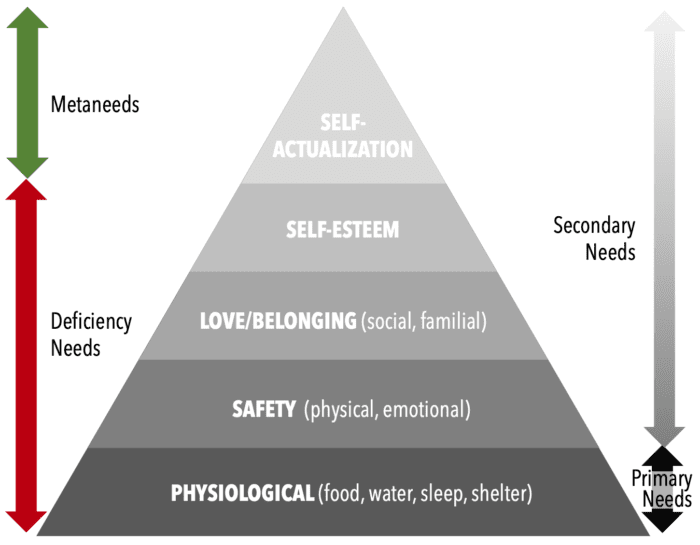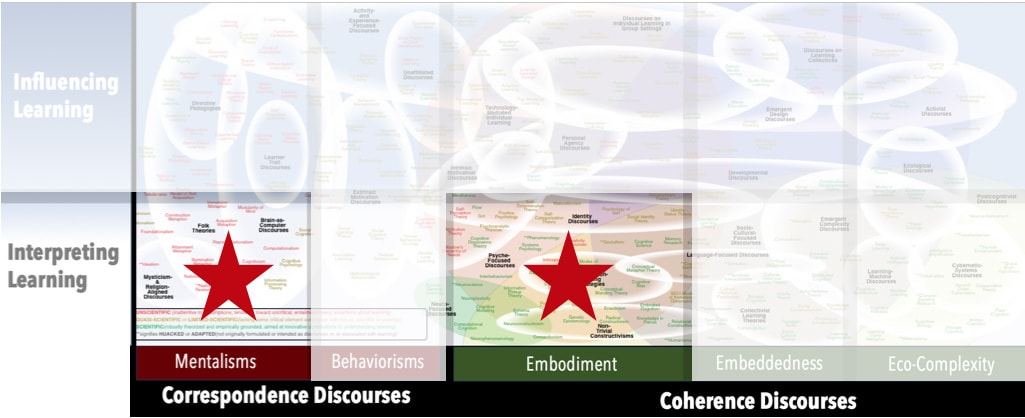AKA
Hierarchy of Needs
Human Needs Theory
Maslow's Motivational Hierarchy
Maslow's Theory of Human Motivation
Need-Hierarchy Theory
Focus
Needs the must be met to enable higher-order learningPrincipal Metaphors
Maslow’s Hierarchy of Needs does not speak to the dynamics of learning, and it is thus not especially attentive to the metaphor and imagery that it invokes. While it draws on a range of notions, the Attainment Metaphor is especially prominent:- Knowledge is … scope of possibility
- Knowing is … goal (mastered needs)
- Learner is … a striver (individual)
- Learning is … attaining (meeting needs)
- Teaching is … supporting; metamotivating (assuming that deficiency needs are met)
Originated
1940sSynopsis
Maslow’s Hierarchy of Needs falls among Motivation Theories. It categorizes and ranks human needs, based on the assumption that more basic needs must be met before one will be motivated to achieve higher-level needs. The popular version of the model is typically presented as a pyramid that culminates with self-actualization, an excellence-oriented metaneeds mode that can only be engaged if all more basic deficiency needs are met.
In more detail, Maslow’s categories include:
- Deficiency Need (Deficiency Motivation) (Abraham Maslow, 1940s) – sources of motivation associated with meeting physiological or psychological requirements. Specific types include:
- Physiological Need (Basic Need; Fundamental Need; Primary Need) (Abraham Maslow, 1940s) – an innate, biological need associated with survival, such as oxygen, water, nutrition, and sleep
- Safety Need (Abraham Maslow, 1940s) – the need/desire to be in a secure and predicable space, free of threats
- Love Need (Belonging Need) (Abraham Maslow, 1940s) – the need/desire to feel social acceptance and collective affiliation
- Esteem Need (Self-Esteem Need) (Abraham Maslow, 1940s) – the need/desire for self-esteem, usually articulated in relation to recognition by, admiration of, and/or reputation among others
- Metaneed (B-Motivation; B-Value; Being Motivation; Being Value; Growth Motivation; Metamotivation) (Abraham Maslow, 1940s) – a type of motivation that is oriented to reaching maximal development of personal possibilities, manifest among those who have achieved Self-Actualization:
- Self-Actualization (Abraham Maslow, 1940s) – As the term suggests, Self-Actualization is associated with self-fulfilment and the realization of one’s potential. Originally described as the highest level of psychological development in Maslow's Hierarchy of Needs, Self-Actualization has evolved into a discourse on its own.
- Self-Transcendence (Abraham Maslow, 1960s) – the desire to move beyond the self by seeking meaning, purpose, and connection with something greater – whether through altruism, spirituality, or service to others
- Secondary Need (Derived Need; Psychological Need) (Abraham Maslow, 1940s) – any need that is not a biological necessity
- Being Cognition (B-Cognition) (Abraham Maslow, 1940s) – the growth toward and realization of Self-Actualization, often manifest in a Flow sort of experience (contrast: Deficiency Cognition, below)
- Deficiency Cognition (D-Cognition) (Abraham Maslow, 1940s) – habitual, everyday habits of perception and interpretation (contrast: Being Cognition, above)
- Metapathology (Abraham Maslow, 1940s) – a feeling or state of discontentment associated with an inability to meet meet one's Metaneeds
- Conscious Moment – awareness of the current moment, usually defined in terms of the time it takes for Sensory Memory (see Memory Science) to decay – i.e., 2–5 seconds
- Peak Experience (Abraham Maslow, 1940s) – the momentary, and typically sudden, experience of self-transcending awe, insight, and/or joy
- Specious Present (E. Robert Kelly, 1880s) – the conscious sense of experiencing/inhabiting/being in a distinct moment, labeled “specious” because the moment is necessarily fleeting
- Timeless Moment – an experience characterized by sensations of connectedness with the more-than-self and of the dissolution of time
- Need-to-Belong Model (Belongingness Theory) (Abraham Maslow, 1940s) – the psycho-emotional need to be a full member of a group, with a status that goes beyond simple acquaintance, paid admission, and/or official inclusion
- Theory X / Theory Y (Douglas McGregor, 1960s) – an application of Maslow’s Hierarchy of Needs at the group level, using the model give advice to team managers by distinguishing between workers focused on satisfying lower-level needs (Theory X, who require rigid environments and strict discipline) and workers motivated by higher-order needs (Theory Y, who require less structure and oversight)
- Theory Z (Japanese Management Style) (William Ouchi, 1980s) – a direct response to Theory X / Theory Y (see above), and aligning more with Cognitive Motivation Theories than Drives Needs, & Desires Theories, describing team-oriented workers who thrive on a sense of cohesiveness in the organization
- School Belonging (Carol Goodenow, Kathleen Grady, 1990s) – the feeling of attachment or affiliation to one’s school, which is argued to be a critical element in one’s development and a fundamental aspect in the emergence of one’s sense of self
- Seven Levels of Consciousness (Barrett’s Levels of Consciousness) (Richard Barrett, 1990s) – a model that extends Maslow’s Hierarchy of Needs into personal and organizational development. The model is intended to help individuals and organizations evolve from fear-based motivations (lower levels) to purpose-driven, high-consciousness living (higher levels). The levels are: 1. Survival Consciousness (basic needs, security, safety); 2. Relationship Consciousness (belonging, love, interpersonal connections); 3. Self-Esteem Consciousness (performance, achievement, personal recognition); 4. Transformation Consciousness (adaptability, growth, continuous learning); 5. Internal Cohesion Consciousness (finding purpose, meaning, alignment with core values); 6. Making a Difference Consciousness (service, collaboration, contributing to the greater good); 7. Service Consciousness (selfless contribution, compassion, global consciousness).
Commentary
A first important note about Maslow’s Hierarchy of Needs is that neither the content nor the form of the popular version are especially true to Abraham Maslow's actual theory. For instance, while he did describe his model as a “hierarchy,” he saw it less as a ladder or pyramid and more as nested levels, each of which included but transcended previous levels. The popular pyramid was actually developed some years after Maslow published his work, in large part for pragmatic reasons by workshop leaders and others who were perhaps more interested in resonance with audiences than fidelity to the author. That said, the strongest criticisms of all versions of Maslow’s Hierarchy of Needs are focused on culturalist and ageist biases. Many assert the model is a “First World” theory that amplifies and privileges trivial concerns. Moreover, it is suggestive of sensibilities and priorities in individualistic societies, and it does not reflect worldviews and motivations (and, consequently, the levels) of collectivist societies. (To be fair, Maslow partially addressed some of these issues with the suggestion of a self-transcendence level, which has some resonance with non-western sensibilities.) Finally, Maslow has been heavily criticized in this work for having appropriated, misinterpreted, and/or mischaracterized the cultural knowledge of the Siksika First Nation, part of the Blackfoot Confederacy.Authors and/or Prominent Influences
Abraham MaslowStatus as a Theory of Learning
Maslow’s Hierarchy of Needs can be construed as a theory of learning – or, perhaps more accurately, a description of what must be in place for learners to engage with the sorts of higher-order concepts that are encountered in schools.Status as a Theory of Teaching
Maslow’s Hierarchy of Needs has figured prominently in discussions of formal education for more than a half-century, suggesting that it has been embraced by educators as a useful theory to inform their work.Status as a Scientific Theory
Maslow’s Hierarchy of Needs is heavily contested. It lacks a robust evidence base and is unable to answer to many observations that contradict core assumptions and assertions. Indeed, numerous researchers have published research that undercut different aspects of the model.Subdiscourses:
- Being Cognition (B-Cognition)
- Conscious Moment
- Deficiency Cognition (D-Cognition)
- Deficiency Need (Deficiency Motivation)
- Esteem Need (Self-Esteem Need)
- Love Need (Belonging Need)
- Metaneed (B-Motivation; B-Value; Being Motivation; Being Value; Growth Motivation; Metamotivation)
- Metapathology
- Need-to-Belong Model (Belongingness Theory)
- Peak Experience
- Physiological Need (Basic Need; Fundamental Need; Primary Need)
- Safety Need
- School Belonging
- Secondary Need (Derived Need; Psychological Need)
- Self-Actualization
- Self-Transcendence
- Seven Levels of Consciousness (Barrett’s Levels of Consciousness)
- Specious Present
- Theory X / Theory Y
- Theory Z (Japanese Management Style)
- Timeless Moment
Map Location

Please cite this article as:
Davis, B., & Francis, K. (2025). “Maslow’s Hierarchy of Needs” in Discourses on Learning in Education. https://learningdiscourses.com.
⇦ Back to Map
⇦ Back to List
